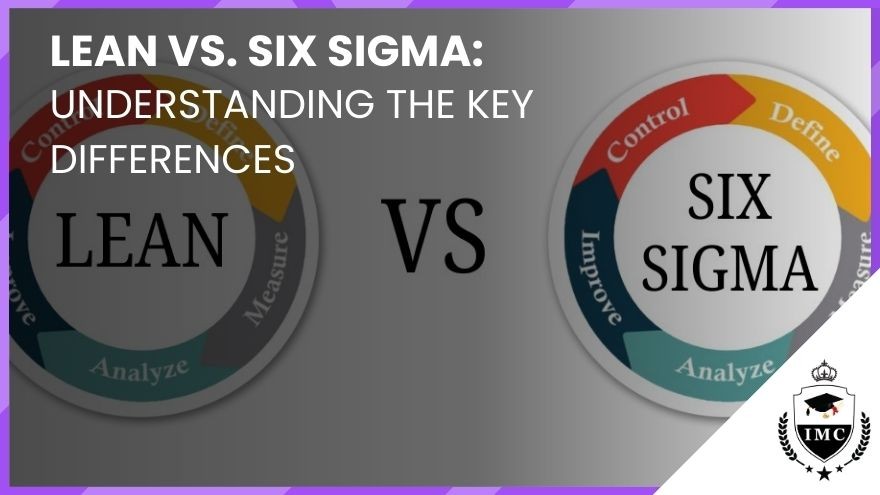In business environment, efficiency and quality are essential for success. Two widely respected methodologies, Lean and Six Sigma, have been driving performance improvements across industries for decades. While they are often discussed together, Lean and Six Sigma focus on different aspects of improvement. Lean aims to minimize waste and maximize value, whereas Six Sigma is centered on reducing variation and defects. By understanding their differences, companies can better decide which approach (or combination of both) suits their needs.
IMC Institute is proud to offer comprehensive Lean Six Sigma certification programs, including Yellow, Green, Black, and Master Black Belt certifications. We also provide PMP certification accredited by PMI, with a special 50% discount for those enrolling in both Lean Six Sigma and PMP programs. This article will explore the core differences between Lean and Six Sigma, real-world applications of each, and the advantages of combining these methodologies.
What is Lean?
Lean is a methodology focused on creating more value with fewer resources. Originating from the Toyota Production System, Lean emphasizes the elimination of waste (any activity that doesn’t add value) and promotes continuous improvement. Lean principles have been applied in various industries, from manufacturing to healthcare, to streamline operations and enhance productivity.
Key Principles of Lean:
- Identify Value - Define what value means from the customer’s perspective.
- Map the Value Stream - Analyze the entire flow of a process and identify non-value-adding steps.
- Create Flow - Organize processes so that they flow smoothly with minimal interruptions.
- Establish Pull - Only produce what is needed when it is needed.
- Pursue Perfection - Continuously improve processes to approach perfection.
Real-World Example of Lean in Action: In the manufacturing industry, Lean principles have been widely adopted to reduce excess inventory and waiting times. For example, Toyota's use of Lean allowed them to produce vehicles based on customer demand, thus minimizing waste and reducing production costs. This approach also improved vehicle quality, setting a new standard in the automotive industry.
What is Six Sigma?
Six Sigma, developed by Motorola in the 1980s, is a data-driven methodology focused on reducing defects and variability in processes. Its goal is to achieve near-perfection, allowing only 3.4 defects per million opportunities. Six Sigma follows the DMAIC (Define, Measure, Analyze, Improve, Control) framework to systematically address process inefficiencies and improve quality.
Key Principles of Six Sigma:
- Define - Define the problem and set project goals.
- Measure - Collect data to understand the current state of the process.
- Analyze - Identify root causes of defects or variations.
- Improve - Implement solutions to address root causes.
- Control - Establish controls to sustain improvements over time.
Real-World Example of Six Sigma in Action: In the airline industry, Six Sigma has been used to improve baggage handling processes. American Airlines, for instance, applied Six Sigma to reduce errors in baggage tracking, achieving a dramatic reduction in lost or delayed luggage. By systematically analyzing and controlling the process, Six Sigma helped American Airlines enhance customer satisfaction and reduce operational costs.
Key Differences Between Lean and Six Sigma
While Lean and Six Sigma share a common goal of improving efficiency, they approach it from different angles.
|
Aspect |
Lean |
Six Sigma |
|---|---|---|
|
Focus |
Eliminate waste to maximize value. |
Reduce variability and defects. |
|
Primary Goal |
Speed, efficiency, and cost reduction. |
Consistency, quality, and defect reduction. |
|
Methodology |
Continuous improvement and waste reduction. |
Data-driven analysis and statistical tools. |
|
Key Tools |
5S, Kaizen, Value Stream Mapping, Kanban. |
DMAIC, Control Charts, Fishbone Diagram. |
|
Implementation |
Easier to implement in smaller scale. |
Often requires more time, resources, and training. |
Lean vs. Six Sigma in Different Industries
Understanding where each methodology shines can help businesses determine which one best fits their needs.
1. Manufacturing
- Lean in Manufacturing: Many manufacturing companies use Lean to optimize production lines, reduce excess inventory, and shorten lead times.
- Six Sigma in Manufacturing: Six Sigma is particularly useful in manufacturing to minimize defects and improve product quality. For instance, General Electric applied Six Sigma to reduce defects in their production processes, saving billions of dollars.
2. Healthcare
- Lean in Healthcare: Lean has been successfully implemented in hospitals to reduce wait times and streamline patient flow. For example, Virginia Mason Medical Center in Seattle reduced patient wait times by implementing Lean principles.
- Six Sigma in Healthcare: Six Sigma is used in healthcare to minimize errors in processes like lab testing and surgical procedures. Six Sigma tools helped Mount Sinai Hospital in New York City reduce medical errors in patient care.
3. Finance
- Lean in Finance: Lean helps finance companies eliminate redundant processes, such as paperwork and approvals, to enhance customer service.
- Six Sigma in Finance: Six Sigma focuses on error reduction in data-intensive tasks. For instance, Bank of America implemented Six Sigma to improve customer satisfaction by addressing errors in account handling and transaction processing.
Combining Lean and Six Sigma: Lean Six Sigma
Combining Lean and Six Sigma creates a powerful approach to process improvement. Known as Lean Six Sigma, this hybrid methodology leverages the strengths of both Lean and Six Sigma to drive efficiency and quality. Lean Six Sigma uses Lean to eliminate waste and Six Sigma to reduce variation, resulting in streamlined processes with fewer errors.
Example of Lean Six Sigma in Retail:
Retail giants like Amazon have applied Lean Six Sigma to enhance warehouse efficiency and ensure timely deliveries. By removing bottlenecks (Lean) and reducing order processing errors (Six Sigma), Amazon has managed to create a highly efficient and reliable fulfillment network.
How Lean Six Sigma Certification Benefits Your Career
Professionals equipped with Lean Six Sigma skills are highly sought after across various sectors. By learning Lean Six Sigma, you not only gain expertise in reducing waste and errors but also develop analytical and problem-solving skills applicable to any industry.
Why Choose IMC Institute for Your Certification
At IMC Institute, we offer a range of Lean Six Sigma certifications to fit your professional goals:
- Yellow Belt: Introductory level for understanding basic Lean Six Sigma concepts.
- Green Belt: Intermediate level, ideal for professionals looking to lead small projects.
- Black Belt: Advanced level for those leading larger projects and training others.
- Master Black Belt: Expert level, designed for leaders driving organizational change.
Additionally, IMC Institute offers PMP certification, which is accredited by PMI and highly respected worldwide. For those looking to expand their skills, we have a special offer: a 50% discount when you enroll in both Lean Six Sigma and PMP certifications. This unique combination equips you with project management expertise and process improvement skills, a winning combination for advancing in today’s business world.
Summary
Whether you're drawn to Lean’s focus on speed and efficiency or Six Sigma’s emphasis on precision and quality, both methodologies offer valuable tools to help organizations thrive. Lean Six Sigma unites the best of both approaches, helping companies achieve streamlined operations and exceptional quality. By earning a Lean Six Sigma certification from IMC Institute, you not only increase your value as a professional but also join a network of forward-thinking individuals committed to excellence.
Take the first step towards transforming your career with a Lean Six Sigma certification from IMC Institute. Embrace the power of process improvement and open doors to exciting opportunities in any industry.






